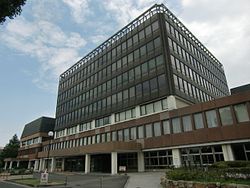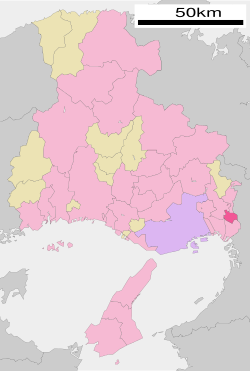
Hyōgo Prefecture is a prefecture of Japan located in the Kansai region of Honshu. Hyōgo Prefecture has a population of 5,469,762 and a geographic area of 8,400 square kilometres. Hyōgo Prefecture borders Kyoto Prefecture to the east, Osaka Prefecture to the southeast, and Okayama and Tottori prefectures to the west.

Toyonaka is a city in Osaka Prefecture, Japan. As of 1 May 2023, the city had an estimated population of 399,263 in 179651 households and a population density of 5700 persons per km2. The total area of the city is 36.39 square kilometres (14.05 sq mi). It is a suburban city of Osaka City and a part of the Kyoto-Osaka-Kobe metropolitan area.

Ikeda is a city in Osaka Prefecture, Japan. As of 31 March 2023, the city had an estimated population of 103,064 in 49723 households and a population density of 4700 persons per km². The total area of the city is 22.14 square kilometres (8.55 sq mi). It is a suburban city of Osaka City and a part of the Kyoto-Osaka-Kobe metropolitan area.

Amagasaki is an industrial city located in Hyōgo Prefecture, Japan. As of 30 November 2022, the city had an estimated population of 455,555 in 223,812 households, and a population density of 9000 persons per km². The total area of the city is 50.72 km2 (19.58 sq mi).

Nishinomiya is a city located in Hyōgo Prefecture, Japan. As of 1 November 2022, the city had an estimated population of 484,368 in 218,948 households and a population density of 4,800 persons per km². The total area of the city is 99.98 square kilometres (38.60 sq mi). Nishinomiya is an important commercial and shipping city in the Kansai region with the third largest population in Hyōgo Prefecture. Nishinomiya is best known as the home of Koshien Stadium, where the Hanshin Tigers baseball team plays home games and where Japan's annual high school baseball championship is held.

Takarazuka is a city located in Hyōgo Prefecture, Japan. As of 1 February 2024, the city had an estimated population of 221,846 in 96,729 households and a population density of 2,200 persons per km². The total area of the city is 101.80 square kilometres (39.31 sq mi). Known as the "inner parlor" of Kansai, Takarazuka is famous for the Takarazuka Revue, hot springs, and the Takarazuka Tourism Fireworks Display held since 1913. It is also famous as a choice residential area along with Ashiya and Nishinomiya.

Kawanishi is a city located in Hyōgo Prefecture, Japan. As of 30 September 2022, the city had an estimated population of 155,165 and a population density of 2900 persons per km². The total area of the city is 53.44 square kilometres (20.63 sq mi).

Keihanshin is a metropolitan region in the Kansai region of Japan encompassing the metropolitan areas of the cities of Kyoto in Kyoto Prefecture, Osaka in Osaka Prefecture and Kobe in Hyōgo Prefecture. The entire region has a population of 19,302,746 over an area of 13,228 km2 (5,107 sq mi). It is the second-most-populated urban region in Japan, containing approximately 15% of Japan's population.

The Muko River is a river in the south-eastern part of Hyōgo Prefecture. This river was selected as the second most important river in the region by the prefecture governor. Its total length is 66 kilometers, and the drainage area is 496 square kilometers.
The Kohama style was a method of making sake during the Edo period at the Kohama-juku (小浜宿) in the Amagasaki Domain of the former Settsu Province of Japan. Today, the method is used by homebrew enthusiasts or by small boutique brewers.

Amagasaki Domain was a feudal domain under the Tokugawa shogunate of Edo period Japan, located in Settsu Province in what is now the southeastern portion of modern-day Hyōgo Prefecture. It had its administrative headquarters at Amagasaki Castle. The domain extended over parts of Settsu Province that correspond to portions of the cities of Amagasaki, Nishinomiya, Ashiya, Kobe, Itami, and Takarazuka, in modern-day Hyōgo Prefecture. It was controlled by the fudai daimyō Aoyama clan followed by the Sakurai-branch of the Matsudaira clan throughout most of its history.

Tsukaguchi Station is a passenger railway station located in the city of Itami, Hyōgo Prefecture, Japan. It is operated by the West Japan Railway Company.

Inadera Station is a passenger railway station located in the city of Amagasaki, Hyōgo Prefecture, Japan. It is operated by the West Japan Railway Company.

Itami Station is a passenger railway station located in the city of Itami, Hyōgo Prefecture, Japan. It is operated by the West Japan Railway Company ..The station is connected to a large indoor mall to the northwest by a broad pedestrian bridge. Though Hankyu Itami Station is not within easy walking distance, there is also a series of broad pedestrian streets heading in its direction.

Kita-Itami Station is a passenger railway station located in the city of Itami, Hyōgo Prefecture, Japan. It is operated by the West Japan Railway Company.

Hanshinkan Modernism (阪神間モダニズム) identifies the modernist arts, culture, and lifestyle that developed from the region of Japan centered primarily on the Hanshinkan conurbation between Osaka and Kobe, the ideally terrained area between the Rokkō Range and the sea from the 1900s through the 1930s, or the circumstances of that period.

Osaka International Airport, often referred to as Itami Airport, is the primary regional airport for the Kansai region of Japan, including the major cities of Osaka, Kyoto, and Kobe. It is the airport closest to Kyoto, 36 km (22 mi) southwest of Kyoto Station. Itami Airport has a small footprint, covering only 311 hectares of land.

Uejima Onitsura was a Japanese haiku poet of the Edo period. Prominent in Osaka and belonging to the Danrin school of Japanese poetry, Uejima is credited, along with other Edo period poets, of helping to define and exemplify Bashō's style of poetry.
The Ikeda Route, signed as Route 11, is one of the routes of the Hanshin Expressway system serving the Keihanshin area in Japan. It is a radial route that travels in a south to north direction from central Osaka to Itami Airport and Ikeda, with a length of 14.2 kilometers (8.8 mi). Along with its spur route, it has a total length of 21.6 kilometers (13.4 mi).

Inano Shrine is a Shinto shrine located in the Miyamae neighborhood of the city of Itami, Hyogo Prefecture, Japan. The shrine grounds are designated as a national historic site as part of the ruins of Sengoku period Itami Castle.






























